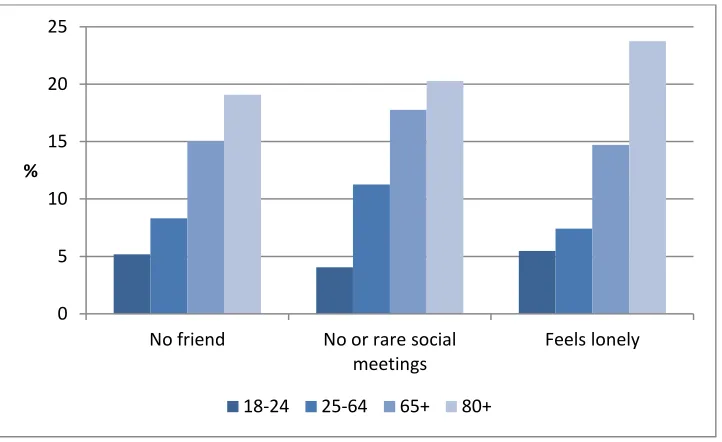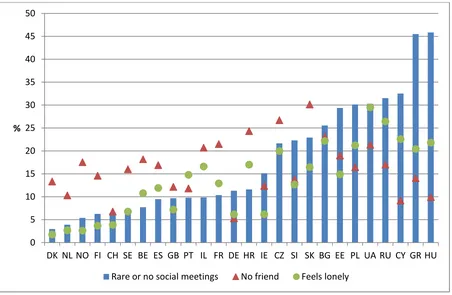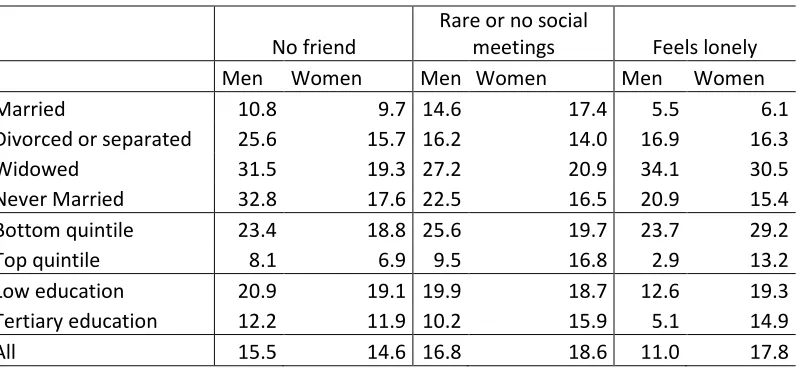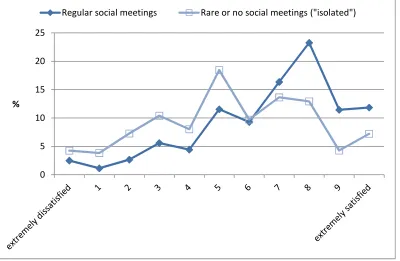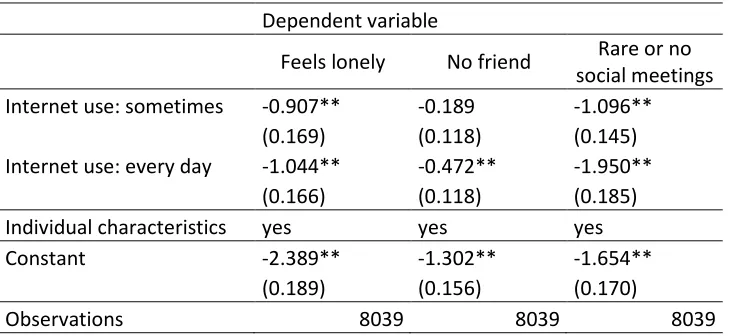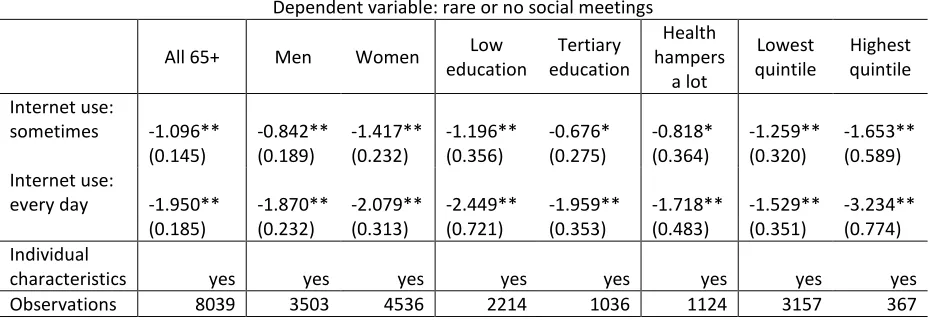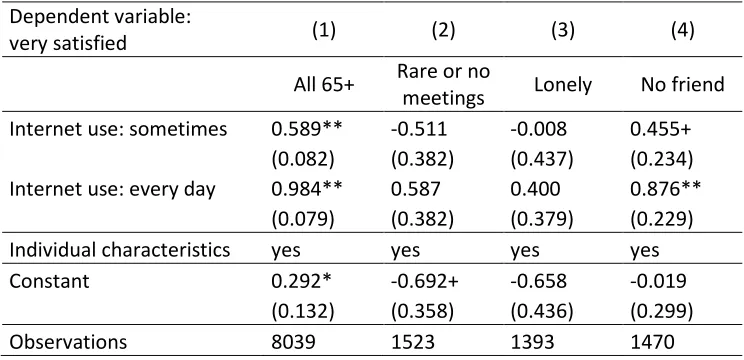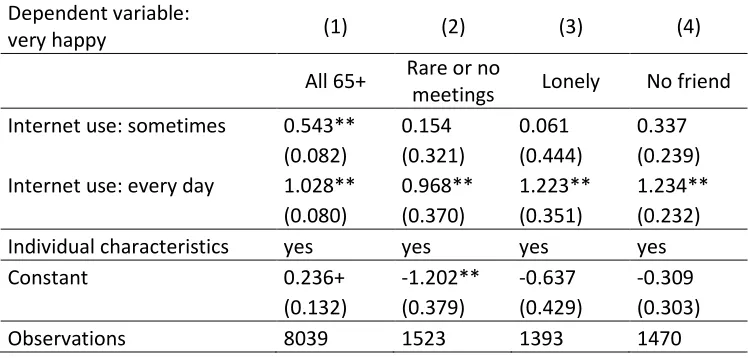Munich Personal RePEc Archive
Happier and less isolated: internet use in
old age
Lelkes, Orsolya
European Centre, Vienna
October 2012
Online at
https://mpra.ub.uni-muenchen.de/42546/
1
Happier and less isolated: internet use in old age
∗∗∗∗Orsolya Lelkes
European Centre for Social Welfare Policy and Research
E-mail: lelkes@euro.centre.org
October 2012
Abstract
This paper explores the impact of internet use in old age on social isolation and on subjective well-being. Does internet use make older people less or more lonely? Does it crowd out face-to-face contacts or enhance them?
We found that social isolation is lower among internet users aged 65 or over. Using a European multi-country cross-sectional dataset with over 11000 observations, we found that those who use the internet regularly have a lower chance of being isolated, more so for those who use the internet every day, controlling for personal characteristics such as income, marital status, gender and health condition. Thus, personal social meetings and virtual contacts are complementary, rather than substituting for each other. Internet use may be a useful way of reducing social isolation.
We also found a positive relationship between regular internet use and self-reported life satisfaction, all else being equal. Our findings were robust in alternative specifications as well.
Keywords: Life Satisfaction, social isolation, internet use, old age
2
"Life is full of misery, loneliness, and suffering - and it's all over much too soon." Woody Allen
The objective of this paper is to explore whether internet use could reduce social isolation in old age, and whether internet use improves subjective well-being or not.
The key question is whether internet use is good or bad for old people. Is it crowding out or reinforcing social relations? Is it a key to the world, increasing subjective quality of life, or does it rather serve as a wall, separating old people from others, from useful activities and good things, and thus ultimately decreasing their well-being?
Old age often brings a deterioration of circumstances in some ways, but a decline in happiness appears to be avoidable. Social isolation tends to increase, partly due to the end of working life or the loss of a spouse or close friends (Lelkes 2010). Ageing may imply a mental decline, or a loss of cognitive capacity (Rohwedder and Willis 2010). Subjective well-being also declines on average. The literature on ageing and happiness tends to conclude that there is a U-shape, with the elderly being better off than the middle aged (Blanchflower and Oswald 2008; Frijters and Beatton 2012), but this holds only if we control for other characteristics and life events which are typical of old age (lower education, worse health, lower incomes, loss of spouse) (Lelkes 2007). This raises the question of whether old age could be a golden age of life, a period with a deep sense of fulfillment and happiness, if we were able to avoid some negative aspects of old age.
Improving well-being in old age is increasingly a policy concern, given population ageing, the increasing share of the old age population. 2012 is the Year of Active Ageing in the European Union. “Active ageing” includes creating more opportunities for older people to continue working, to stay healthy longer and to continue to contribute to society in other ways, for example through volunteering. This policy approach thus moves beyond employment, which tends to be the main focus of national policy-makers and also that of the 2000-2010 Lisbon strategy of the EU. An active, engaged old age can benefit individuals, and also society. Staying engaged and active may prevent cognitive decline, which is more prevalent after retirement (Rohwedder and Willis 2010). Old people have specific experience and knowledge which can help and enrich others. They can be essential in creating and maintaining social networks and personal relationships through grandparenting, mentoring, volunteering or civic activism. Old age is an age with different priorities and
circumstances. Staying healthy and being engaged requires other personal and public strategies than those needed for the working age population.
3
higher social capital (Stiglitz, Sen et al. 2009). Social isolation is a risk factor for premature death, to nearly the same degree as smoking (Berkman and Glass 2000).
The internet may enhance social relations and social capital, and thus contribute to higher subjective well-being. The internet tends to bring the world closer, but this virtual world is different from the actual one, with different benefits and costs. The direct benefits include better access to knowledge, to services, and to social networks, including social media. However, it may crowd out actual face-to-face interactions, which would decrease well-being. Is internet use a complementary or a substitute activity of personal interaction among the old age population?
Internet use can have negative impacts on individuals and their social contacts. Internet use can be excessive, potentially even addictive, especially among young people (Ko, Yen et al. 2012). Many of them spend more time on-line than with friends. Neuroscientists say that access to the internet has a profound impact on the brain, making us lazier in terms of thinking, remembering, or concentrating on a specific activity (Spitzer 2012). E-mails, SMS and notifications constantly interrupt our ongoing activities and make our attention dispersed and less effective. We tend to become less effective in mental arithmetic, remembering birthdays, correct spelling or even navigating on the streets (ibid). Existing evidence suggests that television watching is detrimental to relational activities, and thus reduces life satisfaction (Bruni and Stanca 2008). Too much choice, too many television channels tend to reduce life satisfaction, and an identifiable group of individuals is prone to self control problems (Benesch, Frey et al. 2010). Is internet use different from television watching in terms of its impact on well-being?
Few studies have analysed the impact of the internet on happiness. Kavetsos and Koutroumpis (2011) analyze the effects of information technology on life satisfaction using a pooled
cross-sectional dataset for European countries. They find that a mobile phone, a computer and an internet connection are all associated with higher levels of well-being, whereas television sets are associated with lower levels. The level of mobile and broadband penetration matters for life satisfaction as well. The report published by the Chartered Institute for IT (2010) uses the World Values Survey with 35000 respondents across the globe and finds that internet access has a positive impact on life satisfaction even when controlling for income and other factors known to be important in
determining well-being. A study on Luxembourg (Pénard, Poussing et al. 2011) finds that the positive impact of internet use is stronger for low income and young people. There is specific evidence for the old age population as well. Ford and Ford (2009) examine survey responses of 7,000 retired
Americans 55 years or older, based on the Health and Retirement Study of the University of
Michigan. They find that spending time online reduces depression by 20 percent for senior citizens.
Data and methodology
The analysis is based on a large cross-sectional dataset, the European Social Survey (ESS1), which includes nationally representative samples of 50000 individuals from 26 countries2. Altogether 11000
! "
# $% ! % % ! "
& % ! ! " % % ! ' ! % ( !
4
persons aged 65 or over (our definition of old age) are included in the sample, of whom 2471 are aged 80 or more. The fieldwork was conducted in 2010 and 2011.
We use three key measures of social isolation: lack of a close friend, meeting socially less than once a month and feeling lonely. The survey question for the first one does not use the term “friend”, but rather explores whether the respondent has anyone with whom they can discuss intimate and personal matters. “Intimate” implies things like sex or family matters, “personal” could include work or occupational issues as well. Our measure of feeling lonely includes those who feel lonely most of the time or always.
Our key measure of subjective well-being is self-reported life satisfaction: “All things considered, how satisfied are you with your life as a whole nowadays”? This question is answered on a scale of 0 to 10, where 0 means extremely dissatisfied and 10 means extremely satisfied. In our regression models we use a measure of high satisfaction, which includes all those who gave a score between 8 and 10. This includes about 43% of the old age population in the sample. The reason for using such a measure is that there is evidence that self-reported subjective well-being is not a linear, continuous variable, and the determinants of low well-being differ from those of high well-being (Diener and Emmons 1985). Life satisfaction is one of the many potential measures of subjective well-being. The measure of internet use focuses on the frequency of internet use, including the World Wide Web or e-mail for personal use. Our variable of internet use includes three categories: never (this includes also those who have no access), sometimes and every day. Note that the variable measures private or recreational internet use, and explicitly excludes work related use.
Social isolation in old age
Social isolation increases with age, and affects the old age population the most. Around one out of six people (15-18%) aged 65 or over are isolated in one way or another. The ratio is even higher among those aged 80 or more: around one out of five has no friend or has very limited social meetings, while nearly one in four feels lonely.
/! 0 1 ! 2 2 ! , % ( 3 $
5
Figure 1: Social isolation in different age groups in European countries, 2010 (%)
Source: Own calculations based on ESS2010
Do these three measures refer to the same latent phenomenon of isolation: is it the same people who have no friends, do not meet others and feel lonely? Or are they different people, suggesting that these indicators reflect different facets of social isolation?
We find that each indicator shows a rather different aspect of social isolation, and the overlap between them is rather small. Only 3% of the old age population (65+) are isolated on all three accounts. Only one third of those without a close friend feel lonely, two thirds do not. Similarly, only one third of those who have rare or no social meetings feel lonely, the majority do not. Thus, seeing little of others does not necessarily make one lonely. On the other hand, meeting others, even meeting them a lot, is not a safeguard against the sense of loneliness. We found that a relatively high share, one third of those who feel lonely meet friends or relatives several times a week or daily. This seems to imply that loneliness is largely a state of mind, which is not determined by the lack or presence of actual contact with people.
Meeting others and having a friend are also rather distinct phenomena. Only 5% of the old age population is deprived both in terms of limited social contacts and lack of a friend. Most of those who have no friend still have social meetings at least once a month. Similarly, most of those who have very limited social meetings still have someone to talk to about personal matters.
0 5 10 15 20 25
No friend No or rare social meetings
Feels lonely
%
6
Figure 2: Social isolation across European countries among the population aged 65 or older
Source: Own calculations based on ESS2010
There is a large country variation and alternative measures of social isolation show rather different patterns (Figure 2). The share of individuals who have rare or no social meetings ranges between 3-4% in Denmark and the Netherlands and 45-46% in Greece and Hungary, as shown by Figure 2. There is a correlation between the share of those who have rare or no social meetings and the share of those who feel lonely. In the Nordic countries, where there are relatively few people who have rare social meetings, a small number of people feel lonely. In countries on the right-hand side of the graph, especially Ukraine, Russia, Cyprus, Greece and Hungary, where at least one in three people have rare social meetings, at least 20% of the old age population report that they feel lonely. The third measure, however, having no friend (no one with whom personal or intimate matters could be discussed with) seems to capture a completely different aspect or personal need than the other two measures. In the Nordic countries, many people may not want to share such personal issues with each other, even if they meet regularly and do not feel lonely. This suggests that this measure is strongly culturally dependent.
In the paper, we are not analyzing country differences or country specific patters, as our aim is to provide an overall picture of the already complex relationship of social isolation, internet use and subjective well-being in later age. This overall picture could be supplemented with country specific evidence in future research projects.
Although there are clear gender differences, the prevalence of social isolation differs far more by marital status and socio-economic status, resulting in multiple disadvantage among those who are not married, live on low incomes or have low educational status. Gender differences are more significant within these subgroups, than within the total old age population. For example, there is a
0 5 10 15 20 25 30 35 40 45 50
DK NL NO FI CH SE BE ES GB PT IL FR DE HR IE CZ SI SK BG EE PL UA RU CY GR HU
%
7
minor difference between the shares of men and women with no friends, but of those who are never married, men are twice as likely to be without a friend.
[image:8.595.77.476.276.461.2]Men without a spouse (divorced, separated, widowed or never married) suffer from social isolation more than women on all measures: they are more likely to feel lonely, to have very few social contacts or have no friend. The largest gender difference relates to having someone with whom they could talk about personal matters. For example, nearly twice as many never married old men say that they do not have such a person than never married women do. Married men may be more sociable or have more social skills than men who do not have a spouse. This holds for women, too, but women without a spouse do not fare as badly as men in terms of not having a friend.
Table 1: Alternative measures of social isolation by marital status, income group, educational attainment and gender among the population aged 65 or older, 2010
No friend
Rare or no social
meetings Feels lonely
Men Women Men Women Men Women
Married 10.8 9.7 14.6 17.4 5.5 6.1
Divorced or separated 25.6 15.7 16.2 14.0 16.9 16.3
Widowed 31.5 19.3 27.2 20.9 34.1 30.5
Never Married 32.8 17.6 22.5 16.5 20.9 15.4
Bottom quintile 23.4 18.8 25.6 19.7 23.7 29.2
Top quintile 8.1 6.9 9.5 16.8 2.9 13.2
Low education 20.9 19.1 19.9 18.7 12.6 19.3
Tertiary education 12.2 11.9 10.2 15.9 5.1 14.9
All 15.5 14.6 16.8 18.6 11.0 17.8
Source: Own calculations based on ESS2010
8
Figure 3: Distribution of self-reported life satisfaction scores among elderly with and without regular
social contacts (population aged 65 or older), 2010
Source: Own calculations based on ESS2010
Internet use: digital divide in old age
[image:9.595.74.474.114.375.2]Internet use is strongly patterned by age, as expected. The majority (78%) of the old age population has no access to internet (the majority) or never uses it (Table 2). Only 10% of them are occasional and 12% are daily users. These ratios are 20% and 72% among 18-24 year olds.
Table 2: Internet use by age group
Internet/e-mail/www for
personal use 18-24 25-64 65+ Total
never 8.1 31.8 78.1 36.4
sometimes 20.1 26.3 9.9 22.5
every day 71.7 41.9 12.0 41.2
Total 100.0 100.0 100.0 100.0
Source: Own calculations based on ESS2010
There is also a strong digital divide among the old age population. Internet use is more limited among women, individuals with low education, low income and those with severe health impairment. Lower socio-economic groups tend to be excluded from internet use: the overall majority, around 90%, of the old age population with low income and also those with low education say that they never use the internet (Table 3). Income level and education seems to be very strongly correlated with internet use. The difference in the rates of daily internet use is almost tenfold, both comparing the bottom and the top income fifth and the lowest and highest education groups.
0 5 10 15 20 25
%
9
Table 3: Internet use among specific subgroups of the population aged 65 or over
Internet/e-mail/www for
personal use
All 65+ Men Women Low education
Tertiary education
Bottom income quintile
Top income quintile
Health hampers
a lot
never 78.1 70.5 84.0 90.8 51.0 90.0 37.6 91.6
sometimes 9.9 11.5 8.6 5.4 18.2 5.3 16.8 3.6
every day 12.0 18.0 7.4 3.8 30.8 4.7 45.7 4.8
100.0 100.0 100.0 100.0 100.0 100.0 100.0 100.0
Source: Own calculations based on ESS2010
The key question of our interest is whether internet use can reduce social isolation, and whether it ultimately contributes to an increase in subjective well-being.
Internet use and social isolation
We explored whether internet use is associated with lower occurrence of social isolation. The estimated logit regression models use three alternative measures of social isolation and a set of control variables, which tend to be correlated to subjective well-being (gender, health impairment, income, education level, marital status).
We find that internet users among the old age population are less likely to be isolated. This holds for all measures, including loneliness, lack of social contacts or lack of friends. As expected, those old age individuals who use the internet for personal use, including e-mail, either occasionally or daily are less likely to feel lonely, controlling for other personal characteristics. Internet use thus can bring the world closer, can create a sense of belonging. A related question is whether it brings actual
emotional support as well (we could call it a friend, either virtual or real). We find this is the case: daily internet users are less likely to say that they have nobody with whom they could discuss personal or intimate matters. A related issue is whether internet interactions replace or reinforce personal meetings. We find that that the latter is more likely on average.
10
Table 4: Social isolation and internet use among the population aged 65 or older, logit regressions
Dependent variable
Feels lonely No friend Rare or no social meetings Internet use: sometimes -0.907** -0.189 -1.096**
(0.169) (0.118) (0.145) Internet use: every day -1.044** -0.472** -1.950**
(0.166) (0.118) (0.185) Individual characteristics yes yes yes
Constant -2.389** -1.302** -1.654**
(0.189) (0.156) (0.170)
Observations 8039 8039 8039
Source: Own calculations based on ESS2010
Notes: Dependent variables: No friend = no one to discuss intimate and personal matters with
Rare or no social meetings = Meets socially with friends, relatives or colleagues less than once a month Reference category: never uses internet.
Standard errors in parentheses. * significant at 95%; ** significant at 99%
Individual characteristics include: gender, marital status, income quintile group, education level, health impairment.
Note that our measure does not assess the intensity of these contacts, rather only their existence. Internet contacts may crowd out some personal meetings – this is not something we test - but they certainly contribute to sustaining personal meetings at least on a basic level.
Our key variable of interest is social meetings, as we aim to understand its relationship with internet use. We found evidence that internet use tends to be associated with a lower risk of having no social meetings. Does this relationship vary by social group?
We found that this relationship is stronger for those with low education, which implies that internet access and internet use may be an efficient way of reducing social isolation in this social group. The size of the coefficient is somewhat higher for women than for men. Internet use appears to reduce the risk of isolation among those with health impairments, too, although the effect is somewhat smaller than among the total old age population. Note that all of these estimated logit models include other control variables, thus the potential impact of income, marital status and other basic socio-demographic characteristics is excluded.
11
Table 5: Social isolation and internet use among specific subgroups of the old age population, logit
estimates
Dependent variable: rare or no social meetings
All 65+ Men Women Low education
Tertiary education
Health hampers
a lot
Lowest quintile
Highest quintile Internet use:
sometimes -1.096** -0.842** -1.417** -1.196** -0.676* -0.818* -1.259** -1.653** (0.145) (0.189) (0.232) (0.356) (0.275) (0.364) (0.320) (0.589) Internet use:
every day -1.950** -1.870** -2.079** -2.449** -1.959** -1.718** -1.529** -3.234** (0.185) (0.232) (0.313) (0.721) (0.353) (0.483) (0.351) (0.774) Individual
characteristics yes yes yes yes yes yes yes yes Observations 8039 3503 4536 2214 1036 1124 3157 367
Source: Own calculations based on ESS2010
Notes: Dependent variable: Meets socially with friends, relatives or colleagues less than once a month Reference category: internet use: never. Individual characteristics: see Table 4. Standard errors in parentheses. * significant at 95%; ** significant at 99%
This seems to imply that the positive impact of internet use is strongest among some of the most disadvantaged groups. Older people, who have low education and still have internet access (as shown in Table 3, this is only 9%) appear to benefit much more from the positive impact of internet (in terms of reducing social isolation) than people with high education, although the same does not apply to low and high income groups.
Our results reveal a relationship between internet use and social isolation, but it may not be causal. These results may be due to a selection effect, where “sociable” people are more likely to talk to others personally and also keep in touch on the internet. Our results seem to clearly imply, however, that internet use does not replace personal contacts.
What is the overall impact of internet use on subjective well-being? Given its apparent role in reducing social isolation, we expect a positive relationship. We also know that social isolation tends to bring lower levels of subjective well-being and greater prevalence of depression and mental health problems. What about the well-being impact of internet use among those who happen to be
12
Table 6: Life satisfaction, internet use and social isolation among the population aged 65 or over, logit
estimates
Dependent variable:
very satisfied (1) (2) (3) (4)
All 65+ Rare or no
meetings Lonely No friend Internet use: sometimes 0.589** -0.511 -0.008 0.455+
(0.082) (0.382) (0.437) (0.234) Internet use: every day 0.984** 0.587 0.400 0.876**
(0.079) (0.382) (0.379) (0.229) Individual characteristics yes yes yes yes
Constant 0.292* -0.692+ -0.658 -0.019
(0.132) (0.358) (0.436) (0.299)
Observations 8039 1523 1393 1470
Source: Own calculations based on ESS2010
Notes: Dependent variable: very satisfied = scores 8, 9 or 10 on a scale of 0 to 10. Logit model.
Reference category: internet use: never. Individual characteristics: gender, marital status, income quintile group, education level, health impairment. Standard errors in parentheses. * significant at 95%; ** significant at 99%
We find that older internet users are more likely to report high scores of life satisfaction, controlling for income, education and others factors. On average, internet use is most likely to have a positive relationship with well-being among the population age 65 or older. The positive effects of internet access and internet use (including its likely impact on reducing social isolation) outweigh its potential negative effects (internet overuse, attention deficit, deterioration of cognitive skills).
We also explored the relationship of internet use and subjective well-being among those who are socially isolated. According to our calculations, those who suffer from loneliness or lack of social meetings, do not benefit from internet use: it does not tend to make them more satisfied. Internet use appears to boost satisfaction only for those who say that they have nobody with whom they can intimately talk to. This seems to suggest that internet use may be a means to prevent social isolation, but it is not able to neutralize the negative psychological impacts for those who are isolated.
13
Table 7: Dissatisfaction, internet use and social isolation among the population aged 65 or over, logit
estimates
Dependent variable:
very dissatisfied (1) (2) (3) (4)
All 65+ Rare or no
meetings Lonely No friend Internet use: sometimes -0.823** 0.196 0.341 -0.160
(0.163) (0.331) (0.330) (0.290) Internet use: every day -1.198** -0.721 -0.451 -0.710*
(0.172) (0.561) (0.367) (0.342) Individual characteristics yes yes yes yes Constant -2.729** -2.498** -1.605** -2.400**
(0.201) (0.382) (0.365) (0.357)
Observations 8039 1523 1393 1470
Source: Own calculations based on ESS2010
Notes: Dependent variable: very dissatisfied = scores 0 to 3 on a scale of 0 to 10. Logit model.
Reference category: internet use: never. Individual characteristics: see Table 6. Standard errors in parentheses. * significant at 95%; ** significant at 99%
Following this, we used self-reported happiness as a dependent variable. Similar to our analysis on life satisfaction, we focus on those with high levels of happiness, and use a cut-off point for those who report scores from 7 to 10 on a scale of 0 to 10. The logit estimates suggest that internet users are more likely to report high levels of happiness. This suggests a potential welfare-enhancing effect of internet use for these groups, but calls for the need of further, in-depth validation of the causal impact.
Table 8: Happiness, internet use and social isolation among the population aged 65 or over, logit estimates
Dependent variable:
very happy (1) (2) (3) (4)
All 65+ Rare or no
meetings Lonely No friend Internet use: sometimes 0.543** 0.154 0.061 0.337
(0.082) (0.321) (0.444) (0.239) Internet use: every day 1.028** 0.968** 1.223** 1.234**
(0.080) (0.370) (0.351) (0.232) Individual characteristics yes yes yes yes
Constant 0.236+ -1.202** -0.637 -0.309
(0.132) (0.379) (0.429) (0.303)
Observations 8039 1523 1393 1470
Source: Own calculations based on ESS2010
Notes: Dependent variable: very happy = scores 8, 9 or 10 on a scale of 0 to 10. Logit model.
[image:14.595.70.444.511.690.2]14
Further research could shed light on the specific impact of internet use on the frequency and nature of personal social contacts. In particular, it would be useful to explore potential internet overuse among older people. This group probably constitutes a minority at the moment, but in their case the internet may well crowd out personal meetings, as found with younger people.
The internet is an ever-increasing medium for maintaining social contact, via e-mails and social media (Facebook, twitter, Google+ and others). Since our measure is internet use for private purposes, we can assume that it is also a proxy for maintaining contact with other people in virtual reality.
Our results suggest that people still want to see each other personally if they have interaction via the internet. We found that internet use is associated with lower social isolation among the population aged 65 or over, thus personal social meetings and virtual contacts are complementary, rather than substitutive of each other. In particular, we tested the relationship between lack of personal
meetings and internet use for private purposes. We found that older people with regular internet use have a lower probability of not seeing others, and more so for those who use the internet every day, controlling for personal characteristics such as income, marital status, gender and health condition. We also found a positive relationship between regular internet use and self-reported life satisfaction, controlling for income, education and other personal characteristics, which may influence well-being. We used two alternative specifications: high and low levels of life satisfaction. As a robustness check, we also tested these results on self-reported happiness. In all three models, internet users had a higher subjective well-being, and daily users even more so, controlling for other characteristics. These results suggest a potential positive impact of internet use for the old age population on average. Internet use is expected to have a positive impact on subjective well-being and on social relations as long as it is not addictive.
15
Becchetti, L., A. Pelloni and F. Rossetti (2008). "Relational Goods, Sociability, and Happiness." Kyklos, Wiley Blackwell 61(3): 343-363.
Benesch, C., B. S. Frey and A. Stutzer (2010). "TV Channels, Self-Control and Happiness." The B.E. Journal of Economic Analysis & Policy 10(1): Article 86.
Berkman, L. F. and T. Glass (2000). Social integration, social networks, social support, and health. Social Epidemiology. L. F. Berkman and I. Kawachi. Oxford, Oxford University Press.
Blanchflower, D. G. and A. Oswald (2008). "Is Well-being U-Shaped over the life cycle?" Social Science & Medicine 66(8): 1733-1749.
Bruni, L. and L. Stanca (2008). "Watching alone: Relational goods, television and happiness." Journal of Economic Behavior and Organization 65(3-4): 506-528.
Chartered Institute for IT (2010). The Information Dividend: Can IT make you 'happier'? London, Chartered Institute for IT
Cornwell, E. Y. and L. J. Waite (2009). "Social Disconnectedness, Perceived Isolation, and Health among Older Adults." Journal of Health and Social Behavior 50(1): 31-48.
Diener, E. and R. A. Emmons (1985). "The independence of positive and negative affect." Journal of Personality and Social Psychology 47: 1105-1117.
Ford, G. S. and S. G. Ford (2009). Internet Use and Depression Among the Elderly, Phoenix Center Policy Paper No. 38.
Frijters, P. and T. Beatton (2012). "The mystery of the U-shaped relationship between happiness and age " Journal of Economic Behavior & Organization 82(2-3): 525-542.
Helliwell, J. F. (2006). "Well-Being, Social Capital and Public Policy: What's New?" The Economic Journal 116(510): C34-C45.
Kavetsos, G. and P. Koutroumpis (2011). "Technological affluence and subjective well-being." Journal of economic psychology 32(5): 742-753.
Ko, C.-H., J.-Y. Yen, C.-F. Yen, C.-S. Chen and C.-C. Chen (2012). "The association between Internet addiction and psychiatric disorder: A review of the literature." European Psychiatry 27(1): 1-8.
Lelkes, O. (2007). Happiness over the Life-Cycle. Exploring Age-specific Preferences. Mainstreaming Ageing. Indicators to Monitor Sustainable Policies. B. Marin and A. Zaidi. Aldershot, Ashgate: 359-391.
Lelkes, O. (2010). Social participation and social isolation. Income and living conditions in Europe. Eurostat Statistical books. A. B. Atkinson and E. Marlier. Luxembourg, Publications Office of the European Union: 217-240.
Pénard, T., N. Poussing and R. Suire (2011). Does the Internet make people happier?, CEPS/INSTEAD Working Paper Series 2011-41.
Rohwedder, S. and R. J. Willis (2010). "Mental Retirement." Journal of Economic Perspectives 24(1): 119-38.
Sarracino, F. (2010). "Social capital and subjective well-being trends: Comparing 11 western European countries " Journal of Socio-Economics 39(4): 482-517.
Spitzer, M. (2012). Digitale Demenz: Wie wir uns und unsere Kinder um den Verstand bringen. München, Droemer Knaur.
16
Annex: Key variables and original survey questions
Social isolation
1. “No friend”
Survey question: “Do you have anyone with whom you can discuss intimate and personal matters?” “Intimate” implies things like sex or family matters, “personal” could include work or occupational issues as well.
Answers: 1 yes, 2 no.
We use the term “no friend” for those who gave the answer “no”.
2. “Rare or no social meetings”
Survey question: “How often do you meet socially with friends, relatives or work colleagues? “Meet socially” implies meet by choice rather than for reasons of either work of pure duty.”
Answers: Never, Less than once a month, Once a month, Several times a month, Once a week, Several times a week, Every day.
We created a variable which captures those who answered “never” or “less than once a month”.
3. “Feels lonely”
Survey question: “Please tell me how much of the time during the past week you felt lonely?”
Answers: None or almost none of the time, Some of the time, Most of the time, All or almost all of the time.
Our loneliness variable refers to the last two categories, including those who feel lonely most of the time or always.
Internet use
Survey question: “How often do you use the internet, the World Wide Web or e-mail – whether at home or at work – for your personal use; Personal use is private or recreational use that does not have to do with one’s work or occupation.”
